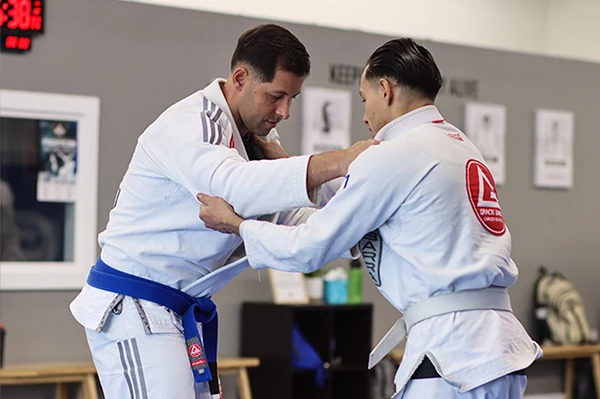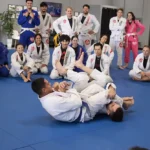“The truth is, most people don’t think about self-defense, until they wish they had.”
That’s how I usually start conversations when people ask me why Brazilian Jiu-Jitsu matters in everyday life. As Head Professor here at Gracie Barra Salt Lake City, I’ve seen time and time again how Jiu-Jitsu doesn’t just build fitness or competitive ability, it gives people real tools to protect themselves and their families.
Self-defense is about more than physical techniques. It’s about awareness, confidence, and the ability to stay calm and think clearly under pressure. And in my experience, there’s no better martial art for that than Jiu-Jitsu.
In this article, I’ll walk you through why Brazilian Jiu-Jitsu is one of the most practical and effective systems for real-life self-defense, and what you should know before you ever need to use it.
Why Self-Defense Matters More Than Ever
We live in a world where personal safety can’t be taken for granted. Whether it’s walking through a parking garage, navigating an unfamiliar neighborhood, or dealing with a threatening situation, it’s not about being paranoid, it’s about being prepared.
“Self-defense is not about being aggressive. It’s about being capable,” I often tell new students. “It’s about knowing you have options if something goes wrong.”
Brazilian Jiu-Jitsu (BJJ) focuses on control, leverage, and technique. That means it allows someone smaller or less physically strong to escape danger or subdue an attacker, without needing to strike first.
The Principles of Self-Defense in Jiu-Jitsu
At its core, Jiu-Jitsu teaches you how to stay safe and get out of dangerous situations. The techniques we use are built on four major principles:
1. Distance Management
Learning how to create or close distance with control is the first skill in self-defense. BJJ shows you how to protect your personal space, react appropriately, and manage threats with confidence.
2. Escape Over Engagement
Jiu-Jitsu always favors escape. We teach students to avoid unnecessary confrontation and focus on safely disengaging. “Sometimes the smartest move in self-defense is simply knowing how to get away,” I say during every beginner course.
3. Leverage Beats Strength
You don’t need to be strong to use Jiu-Jitsu. Instead, it uses angles and timing to control or neutralize someone much larger. This is especially powerful for women and smaller individuals.
4. Stay Calm Under Pressure
When adrenaline spikes, it’s hard to think clearly. BJJ training conditions your body and mind to stay calm, breathe, and react with control, even in high-stress scenarios.
Real-World Self-Defense: What You’ll Learn in Jiu-Jitsu
One of the most common questions I get is, “How does this apply in real life?” The answer is: in more ways than you think. Our students don’t just learn sport techniques, they learn real, practical applications for everyday safety.
Here’s a sample of what we cover in our self-defense curriculum:
- Standing control: How to break grips, defend against chokes, and manage space
- Ground survival: What to do if you’re taken down or pushed to the ground
- Escapes: From bear hugs, headlocks, wrist grabs, and mounted positions
- Positional control: How to immobilize a threat without excessive force
- Submissions (last resort): Techniques like joint locks or chokes, taught for extreme cases where de-escalation isn’t possible
We teach these techniques in the context of awareness and decision-making. That’s why BJJ is so effective, not just because of what you learn, but how you learn to think.
Self-Defense for Women: A Conversation with Professor Andrea Warner
When it comes to self-defense, women often face different challenges. That’s why we offer a women-only program here at Gracie Barra Salt Lake City, led by Professor Andrea Warner. Her classes focus on real-world scenarios, personal empowerment, and building a strong, supportive community of women who train together.
“One of the first things I teach is how to use your voice,” says Professor Andrea.
“Self-defense starts before anyone ever touches you. It starts with boundaries, confidence, and learning how to read a situation.”
In her classes, women learn how to defend against grabs, takedowns, and close-contact situations. They practice real-life scenarios in a safe, encouraging space.
“We don’t just teach the techniques, we teach women how to trust their instincts,” she says.
“Jiu-Jitsu shows you that you’re capable of protecting yourself, and that changes how you carry yourself in the world.”
Professor Andrea has taught everyone from college students and stay-at-home moms to women recovering from trauma. Many of them say Jiu-Jitsu gave them their confidence back, or helped them discover it for the first time.
How Jiu-Jitsu Builds Long-Term Self-Defense Skills
Jiu-Jitsu isn’t a one-time seminar. It’s a long-term path that reinforces safety habits through muscle memory, mental conditioning, and live practice.
Here’s why that matters:
- You learn to react, not freeze: Regular sparring builds your ability to stay calm and problem-solve under pressure.
- You improve your situational awareness: Jiu-Jitsu sharpens your instincts and teaches you to assess danger quickly.
- You build resilience and confidence: Just knowing that you can defend yourself changes the way you move through the world.
- You gain physical fitness: Strength, flexibility, balance, and endurance all support your ability to defend yourself.
“Every time you show up to class, you’re not just training a technique, you’re programming your mind to stay calm and take control,” I tell students. “That’s the real magic of Jiu-Jitsu.”
Self-Defense Scenarios We Prepare For in Class
Our classes go beyond theory. We design drills and training scenarios to mimic real-life situations in a controlled, safe way. Here are a few of the scenarios we regularly practice:
- Being grabbed from behind in a parking lot
- Being pinned to the ground during an attempted assault
- Defending yourself while seated or against a wall
- Maintaining control over a threat while calling for help
- Protecting someone else while managing a confrontation
We help students understand the legal, ethical, and practical sides of self-defense as well. Knowing when to use a technique and when not to is just as important as knowing how.
What Makes Jiu-Jitsu Different from Other Self-Defense Systems?
There are many ways to learn self-defense, so why Jiu-Jitsu?
Here’s what sets it apart:
- Real resistance training: Jiu-Jitsu is practiced live, so you learn what actually works against someone who’s resisting.
- Control over escalation: You can neutralize a threat without needing to punch or injure someone.
- It works on the ground: Many self-defense systems don’t address ground fighting, where most real-life altercations end up.
- It’s adaptable: Techniques can be adjusted for size, age, or physical ability.
- It builds true confidence: Because you’ve practiced, not just watched or memorized moves.
“The biggest difference is that Jiu-Jitsu makes you capable. It’s not theory, it’s something you’ve done, felt, and lived in training,” I always remind my students.
Self-Defense Isn’t About Fear, It’s About Freedom
This is a point I emphasize often: training in self-defense shouldn’t make you feel paranoid. It should make you feel powerful.
“Jiu-Jitsu gave me the freedom to walk alone without fear,” one of our students recently told me. And that’s exactly it.
Whether you’re a parent who wants to protect your family, a woman who wants to feel safe walking alone, a young adult preparing for college, or someone simply looking to challenge themselves, Jiu-Jitsu can give you that peace of mind.
Final Thoughts from Head Professor Carlos Daniel
If I could tell you one thing, it’s this:
“You don’t have to be a fighter to learn self-defense. You just have to be willing to learn.”
Jiu-Jitsu is for everyone. Whether you’re 12 or 60, athletic or out of shape, introverted or outgoing, you have the right to feel safe and empowered.
At Gracie Barra Salt Lake City, our mission is to give you the tools you need before you ever have to use them. We offer classes for all levels, including beginner-friendly self-defense training and a supportive women-only program led by Professor Andrea Warner.
If you’ve been thinking about learning self-defense, don’t wait for the perfect time. Start now, because the best time to learn is always before you need it.
Book your free trial class today and take the first step toward a stronger, safer you.






